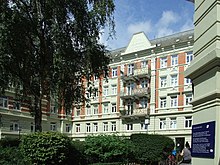Hamburg Castle

The Hamburg Castle is a residential building, the floor plan of which allows front windows for all apartments with good property utilization.
As Hamburg Castle , a floor plan is called, which forms a three-sided enclosed, open onto the street, instead of a closed roadside development with deep rear buildings. This should ensure good lighting and ventilation for all apartments, the two core requirements of reform housing construction in the late imperial era.
The cooperative building and savings association in Hamburg introduced this form, so to speak: 1899 on Stellinger Weg / corner of Methfesselstraße. Above all, the “non-profit organizations” used them frequently until the First World War, such as the consumer, building and savings association “Produktion” for the PRO apartment block on Schleidenplatz / Brucknerstraße built in 1905-07 .
Of the 228 apartments in 1901/02 from the Bau- und Sparverein on Wohldorfer Strasse ( Barmbek-Süd ), 187 had two rooms (without a bathroom). Rent: 240 to 257 marks annually, about a sixth of the total income of a working-class household. The apartments were only given to union and SPD members. Several organizations of the labor movement in Hamburg were founded here. From 1906 to 1925 Adolph Schönfelder lived in this residential complex on Lohkoppelstraße.
The building association was founded in 1892. The initiative came from the Evangelical Social Workers' Association in Hamburg (namely from the later Pastor Paul Ebert ). Besides craftsmen and workers were educated and propertied citizens one, the rubber producer and later Senator Traun . In order to counter the "rummaging" of a social democratic minority, the building association was formed in 1903 into the public limited company Bau-Verein zu Hamburg (formerly Bau- und Sparverein zu Hamburg) AG . Men like Traun acted charitable and practically guardianship. If they had a political intention, it was indirectly. In contrast to “production”, the Bauverein wanted to preserve social conditions, not renew them, and reconcile the classes instead of disempowering the ruling class.
See also
- Rosenhof (building) - the only residential castle in the Bergedorf district






